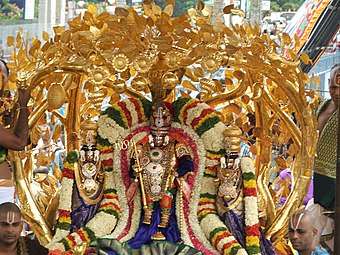Malayappa swami
Malayappa swami is the current utsava murti (presiding deity) in Tirumala Venkateswara Temple, Tirumala. Malayappa swami is worshipped during religious ceremonies and processions wherein it would be inappropriate to use the main deity (for example one which requires the deity to be carried or moved). The two deities are worshipped equally and believed to be non-different in personality.

The Malayappa deity is classed as a Swayambhu and was discovered in 1339 AD. Initial records state his original name as Malai Kuniya Ninra Perumal (Lord stood on the hill which bowed low to Him)[1]
History
Ugra Srinivasa was the first utsava murti at Tirumala temple. In the 14th century AD, it is said that during the procession, fire broke out in the village and destroyed most of the houses. A vision appeared to a devotee stating that Ugra Srinivasa needs to be replaced by a new murthi that would be discovered in the glades of the mountain.
The murthi was found in the place mentioned, a place where the hills appeared to bow very low and hence he was initially known as Malai Kuniya Ninra Perumal. Over the course of time, his name was shortened to Malayappan or Malayappa swami. The location where he was found is still known as Malayyappan Konai (Malayappa's corner).[2]
Description
Malayappa swami is seen in the standing pose and is a replica of Dhruva bera. The two upper arms hold the sankhu and chakram while the two lower arms are in yoga poses. The right arm is in the Varada hasta pose (boon giving) and the lower left arm is in the Katyavalambita pose (palm perpendicular to the ground and resting on the hip). The idol stands about three feet tall on a platform of about 14" height.[2]
Along with the idol, his consorts - Sridevi and Bhudevi were also found and accepted as Swayambhu idols.
Sridevi idol
The idol of Sridevi is always placed on the right hand side of Sri Malayappa swami. The idol is 26" in height and stands on a 4" pedestral. The panchaloha idol is seen with the left hand in the Kataka hasta pose. In this pose, the fingers are partially closed, as if holding a lotus. The right hand hangs loosely on the side and the fingers are held in the Gajakarna pose.[2]
Bhudevi idol
The idol of Bhudevi is always seen on the left hand side of Lord Malayappa swami. The idol is very similar to the idol of Sridevi to signify that Sridevi and Bhudevi represent the two equal spirits of Goddess Lakshmi, the consort of Vishnu.[2] The only difference in the idols is the swap in the hand poses. The idol of Bhudevi has her right hand in Kataka hasta pose and the left in Gajakarna pose.
Worship
Order
The order that represents the lord - Dhruva Bera, Bhoga Srinivasa, Malayappa swami with consorts, Ugra Srinivasa with consorts and Koluvu Srinivasa. Thus Kautaka Bera (Bhoga Srinivasa) should be consecrated directly from Dhruva Bera and the Utsava Bera (Malayappa swami) from the Kautaka Bera. The order continues downwards to the Snapana Bera (Ugra Srinivasa) and Bali Bera (Koluvu Srinivasa).
Daily worship
Malayappa swami is used as the utsava murti and marriage to his consorts and post-marriage rituals are performed to the idol every day. Srivari Kalyanotsavam (Lord's marriage festival) is conducted with Sridevi and Bhudevi. After the marriage ceremony, the lord and his consorts are seated on various vahanams (Vehicle) as part of the Arjitha Brahmotsavam. Dolotsavam seva has the Lord seated in the Addala mandapam (Mirror hall) and entertained with vedic hyms. This is followed by serving the Lord with perfumeries, scents and sandal paste to the vedic hyms of Purusha suktam and Sri Suktam and is followed with Abhishekam as part of the Arjitha Vasanthotsavam celebrations. Arjitha Brahmotsavam and Vasanthotsavam functions are the abridged versions of the Brahmotsavam (9 days) and Vasanthotsavam (3 days) festivals respectively.
In the evening, the Lord and consorts are taken outside the temple as part of the Sahasra Deepalankarana Seva where he is entertained with vedic hyms and annamaya sankirtanas. This is followed by procession on the 4 mada streets surrounding the temple before the lord is taken back into the temple, in time for the ratripuja (night puja).[3]
Weekly sevas
Visesha Puja is performed on Mondays when the 'Chaturdasa kalasa visesha puja' (14 kalasas special puja) is performed to the Lord through the utsava murti. During the Sahasra Kalabhishekam puja, abhishekam is performed to Bhoga Srinivasa, Malayappa swami and Visvaksena.[4]
Annual sevas
During Teppotsavam, the utsava murti along with his consorts are worshipped in the Swami Pushkarini (holy lake adjoining the temple) when the Lord is taken to a float constructed in the lake and worshipped during Phalguna Pournami. Abhideyaka Abhishekam is performed every year in the month of Jyesta (July) to protect the utsava deities from damage during processions and other events. The festival lasts for three days with the deities adorned Vajrakavacham (armour studded with diamonds), Muthyalakavacham (armour studded with pearls) and svarnakavacham (armour of gold) for these days. During Padmavathi Parainayam celebrated in May, the wedding of Lord Srinivasa and the Goddess Padmavathi is celebrated in the Narayanagiri gardens for three days. During the three days, Malayappa swami arrives on Gaja (Elephant), Asva (Horse) and Garuda (Eagle) vehicles while Sridevi and Bhudevi arrive in separate palanquins. After the kalyanotsavam and cultural performances, the lord and consorts are taken back to the temple. Pushpa Pallaki festival is celebrated in July at the start of financial year for the lord with the utsava murtis taken in procession on a richly decorated floral palanquin.[5]
The utsava murtis are taken in procession on various vehicles during the annual Brahmotsavam celebrations.
References
- "Supreme Saviour of Seven Hills". Omnamovenkatesaya.com. 1 January 2006. Archived from the original on 14 April 2007. Retrieved 24 April 2007.
- Ramesan, N (1981). The Tirumala Temple. Tirumala: Tirumala Tirupati Devasthanams.
- "Daily Sevas in Tirumala". TTD. Archived from the original on 6 October 2002. Retrieved 22 April 2007.
- "Periodical Sevas Description at Tirumala Temple". TTD. Archived from the original on 24 July 2012. Retrieved 22 April 2007.
- "Periodical Sevas Description at Tirumala Temple". TTD. Archived from the original on 15 July 2012. Retrieved 22 April 2007.
